Overview of the Degradable Plastic Market
Nadia Akram, Khalid Mahmood Zia, Muhammad Saeed, Waheed Gul Khan
Degradable plastic manufacturing has emerged as an eminent industry due to multiple range of products it offers to the consumers. The diversity induced by the usage of biomaterials lures the customer, making it even more popular for consumption. Degradable plastic industry is a market of multifarious products. The backlash on the massive plastics consumption is expected to be eradicated in the wake of the large business market of degradable plastics in the coming years. The supremacy of the degradable plastic market is not easy to evade by any means. The degradable plastic market is not a solitary market; instead, it encompasses the production, consumption and recycling industry as well. In order to triumph the status of a flourished market a joint venture by the leading companies need to be in harmony. The circular economy of the world is indispensable without a degradable plastic market in future.
Keywords
Bioplastics, Feed Stock, Circular Economy, Global Plastic Market, Degradable
Published online 4/1/2021, 14 pages
Citation: Nadia Akram, Khalid Mahmood Zia, Muhammad Saeed, Waheed Gul Khan, Overview of the Degradable Plastic Market, Materials Research Foundations, Vol. 99, pp 179-192, 2021
DOI: https://doi.org/10.21741/9781644901335-8
Part of the book on Degradation of Plastics
References
[1] V.J. Romero, A. Sanchez, Methodology for multi-criteria design optimization of plastic products with a focus on highly competitive markets, Procedia. Manuf. 41 (2019) 1087–1094. 8th Manufacturing engineering society international conference, (http://creativecommons.org/ licenses/by-nc-nd/4.0/)
[2] A.A. Rodriguez, M. Bosnjak, M.J. Sirgy, Moderators of the self-congruity effect on consumer decision-making: A meta-analysis, J. Bus. Res. 65 (2012) 1179–1188. https://doi.org/10.1016/j.jbusres.2011.07.031.
[3] Z. Babutsidze, A. Chai, Look at me saving the planet! The imitation of visible green behavior and its impact on the climate value-action gap, Ecol. Econ. 146 (2018) 290–303. https://doi.org/10.1016/j.ecolecon.2017.10.017.
[4] I. Confentea, D. Scarpib, I. Russoa, Marketing a new generation of bio-plastics products for a circular economy: The role of green self-identity, self-congruity, and perceived value, J. Bus. Res.112 (2020) 431–439. https://doi.org/10.1016/j.jbusres.2019.10.030
[5] T.A. Cooper. Developments in bioplastic materials for packaging food, beverages and other fast- moving consumer goods, in: N. Farmer (Ed.), Trends in packaging of food, beverages and other fast- moving consumer goods (FMCG) , Woodhead Publishing, 1518 Walnut Street, Suite 1100, Philadelphia, 2013, pp. 108-238.
[6] L. Shen, J. Haufe, M.K. Patel, Product overview and market projection of emerging bio-based plastics PRO-BIP 2009 Final report Group Science, Technology and Society (STS) Copernicus institute for sustainable development and innovation Utrecht University, 2009, 1-243. www.chem.uu.nl/nws www.copernicus.uu.nl
[7] S. Pilla, Engineering applications of bioplastics and biocomposites – An overview, in: S. Pilla, (Ed), Handbook of bioplastics and biocomposites engineering applications. Scrivener ublishing LLC. Co-published by John Wiley & Sons, Inc. Hoboken, New Jersey, and Scrivener Publishing LLC, Salem, Massachusetts, 2011, pp. 1-14.
[8] C. Barbarossa, P. de Pelsmacker, Positive and negative antecedents of purchasing eco-friendly products: A comparison between green and non-green consumers, J. Bus. Ethics. 134(2016) 229–247. https://doi.org/10.1007/s10551-014-2425-z.
[9] H. Chen, W. Jiang, Y. Yang, Y. Yang, X. Man, State of the art on food waste research: A bibliometrics study from 1997 to 2014, J. Clean. Prod. 140 (2016) 840–846. https://doi.org/10.1016/j.jclepro.2015.11.085.
[10] M.S. Jorgensena, A. Remmenb, A methodological approach to development of circular economy options in businesses, Procedia CIRP 69 ( 2018 ) 816 – 821, 25th CIRP Life Cycle Engineering (LCE) Conference, 30 April – 2 May 2018, Copenhagen, Denmark (http://creativecommons.org/licenses/by-nc-nd/4.0/).
[11] L.Sina, A.P. Boix, The circular economy and the bio-based sector – Perspectives of European and German stakeholders, J. Clean. Prod. 201 (2018) 1125-1137 ttps://doi.org/10.1016/j.jclepro.2018.08.019
[12] Y.N. Cho, E. Baskin, It’s a match when green meets healthy in sustainability Labeling, J. Bus. Res. 86(2018) 119–129. https://doi.org/10.1016/j. jbusres.2018.01.050.
[13] S.Y. Ong, K. Sudesh, Soy-based and plant oil-based polyhydroxyalkanoates, in: V. K. Thakur, M. K.Thakur, M.R. Kessler (Eds.),Soy-based bioplastics. Woodhead Publishing Limited, 80 High Street, Sawston, Cambridge CB22 3HJ, UK, 2013, pp,167-191
[14] J. Ying, Z. Li-jun, Study on green supply chain management based on circular Economy, Physics Procedia. 25(2012) 1682-1688. https://doi.org/10.1016/j.phpro.2012. 03.295.
[15] D. Andrews, The circular economy, design thinking and education for sustainability, Local Econ. 30 (2015.) 305-315. https://doi.org/10.1177/ 0269094215578226.
[16] N.M.P. Bocken, S.W. Short, P. Rana, S. Evans, A literature and practice review to develop sustainable business model archetypes, J. Clean. Prod. 65(2014) 42-56. https://doi.org/10.1016/j.jclepro.2013.11.039.
[17] S. Seuring, M. Müller, From a literature review to a conceptual framework for sustainable supply chain management, J. Clean. Prod. 16 (2008) 1699-1710. https://doi.org/10.1016/j.jclepro.2008.04.020.
[18] G. Roos, Business model innovation to create and capture resource value in future circular material chains, RES. 3 (2014) 248-274. https://doi.org/10. 3390/resources3010248.
































